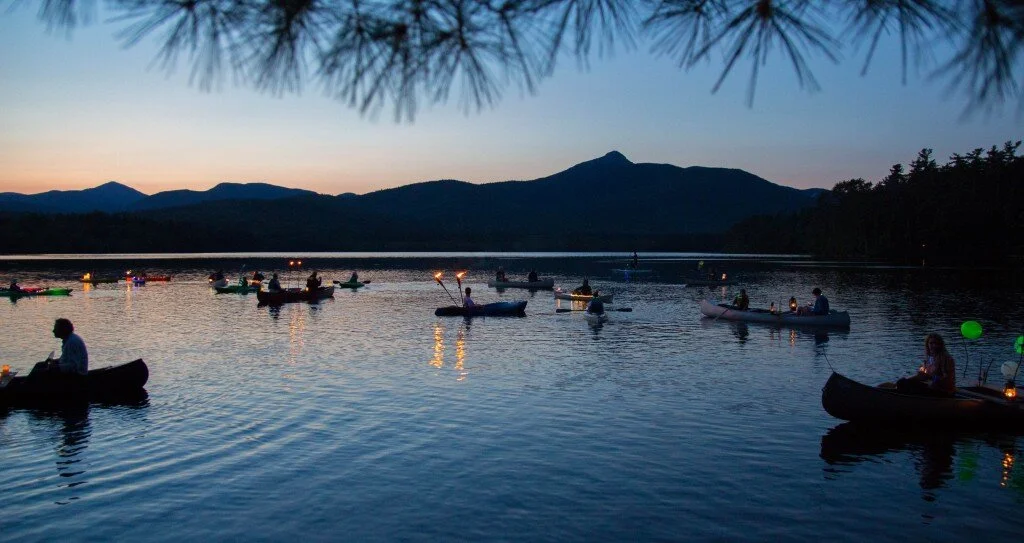The annual Parade of Lights on Chocorua Lake is a Labor Day weekend tradition that began in the 1960s, initiated by Sam’l Newsom and friends and inspired by an element of some Japanese festival celebrations. Sam’ls son Sam Newsom shares his recollection of this tradition that brightens the end of the summer season on the lake.
FAQs: Land Trusts 101
A Summer of Stewardship
A Cold Winter
Preparing for Perpetuity
Iconic View Protected
What is Land Stewardship?
Lynne Flaccus Hired as Stewardship Director
Wildlife Sightings from Summer
by Harriet Hofheinz
It has been a quiet summer and early fall from the point of view of Chocorua Basin wildlife. This is not unusual as animals make themselves scarce and away from humans during the high season of our activity. But there have been a few exceptions. Bears have been spotted in various places, mostly on the prowl for food. One young three year old showed up at my house earlier in the summer interested in my bird feeder. Without much pause, he came right up to the house and knocked on my bedroom window. He hung around often waiting for me to leave before helping himself. I finally took the feeder in and he moved on and was spotted around the basin by several folks. He may have even crossed over Route 16 as a young bear was observed on Washington Hill Road. Additionally, Don Johnson had a Mom with four cubs visiting his back yard from time to time during the summer. That’s a lot of young ones to tend to. If there is not enough food, sometimes a mother bear will dispatch the youngest, chase it away to fend for itself, so she can feed the stronger cubs; cruel, but necessary for the survival of the remaining cubs.
On Columbus Day Rt. 16 trash pickup, Melissa and Troy Emerson found one dead raccoon and one dead barred owl on their watch (see photo). Probably both animals were victims of a deadly car encounter on Rt. 16. Bald eagles and ospreys have been sighted particularly during the later part of the summer. Those sightings are a testament to the extraordinary recovery of these two species after poisonous DDT was found to be the deadly culprit of near extinction of several species of birds in the 50's and early 60's. Those species such as eagles, ospreys, peregrine falcons, loons and many others that breed in NH or the northeast have all rebounded, some better than others. The eagles particularly are doing well, establishing many nesting sites now in NH. That’s the good news. The bad news is that many other land birds (neo-tropical birds) that migrate to nest in New England are not doing so well. For instance, our breeding thrush survey now in its 22nd year, shows steep declines in one of our favorite songsters, the wood thrush. Not as precipitous as the wood thrush, our hermit and veery populations are also showing decline. Our thrush survey is unfortunately indicative of the decline in other songsters who breed in the basin but winter in the south.
Feline wildlife sightings are rare, exciting, and sometimes confusing. What is that wild cat? In the Basin, it's most likely a bobcat, which is enjoying a population rebound in response to a hunting ban enacted in 1989. The ban has been so successful, in fact, that hunting may be allowed again. The organization Voices of Wildlife in New Hampshire is following the issue and collecting signatures for a petition to keep the bobcat protected. For up to date information on the hunting ban, go to their website.
Both the bobcat and the Canadian lynx belong to the Lynx genus, which adds to the confusion. The Canadian lynx is a snow-loving cat that's more populous in northern climates, but is occasionally seen in New Hampshire. If you're lucky enough to get a good look at a cat in the wild, look for these traits:
A bobcat’s stubby tail tip is black in the front and white in the back, so when running away, the white shows clearly. The lynx’s tail tip is all black.
A bobcat’s tracks are catlike running straight. A lynx’s paw print is longer and wider than a bobcat, more like a snowshoe hare (its common prey), and its hide legs are notably longer than its front legs, enabling it to run faster in the snow.
The lynx has a long, mottles grayish coat and pointed ears that are well covered with fur whereas the bobcat is brownish in color, with smaller pointed ears with less fur.
Banner: Betsy Whitman Memishian









